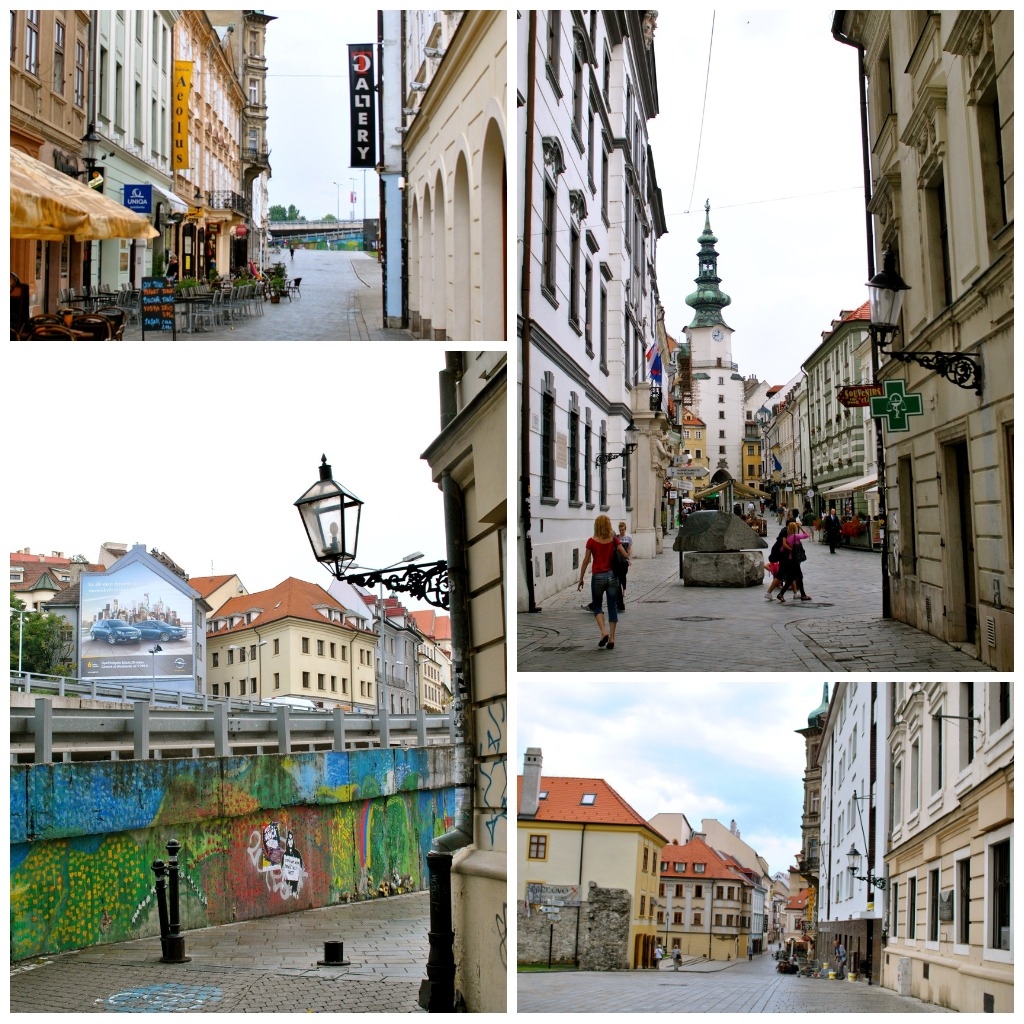
Savour Sicilia: Eat, Drink and Explore with Walk About Italy
Life is about surprising yourself and leaving your comfort zone. As a travel writer, trusting a guided tour to provide a satisfying adventure that would live up to my expectations was doing just that. I had always been fearful of feeling constricted by a tour, of only hitting tourist traps, but nothing, absolutely nothing, could be further from the truth with Walk About Italy.
In fact, it is something Gianni Stanghellini, owner of Walk About Italy, prides himself. “The itineraries avoid places crowded by mass tourism and allow you to walk through cities and paths in nature that give you an authentic experience.”
It may come as a surprise that someone like Gianni, who has a doctorate in geology (minerology), would become a tourism specialist but perhaps it is that very fact that makes him stand out. “I loved my geology background but I have never felt that the laboratory was my place. This is the life that I like.”
Gianni explains he had been guiding while in school, and became passionate about it, so he decided to start his own company in 2012. “I felt the desire to make tours that focus on everything I love to do, the way I love to do it: walking in nature, sharing this experience with others and to be “light,” or “leggero” in Italian, soaking up life so to speak.”
He is motivated solely by his deep passion for his homeland and desire to “share the secrets of my country.” Admittedly, he says when he guides groups, he slips in geological facts from time to time, but that just adds to the uniqueness of the trip.
Walk About Italy tours are intimate, ranging from 6-18 participants — or for something even more cozy, you can hire his company for a personalized tour. Either way, they are the perfect combination of history, nature, culinary excellence, relaxed sophistication and warm hospitality. And they are meticulously planned. To call it a walk is a misnomer. Gianni’s tours are a feast for all senses.

The walking/culinary tour of Tuscany was the founding trip. Gianni: “Hailing from Siena, a captivating medieval town nestled in the heart of Tuscany, Italy, I remain firmly rooted here. The allure of this exquisite place has held me steadfast, and it’s from here that I continue to operate and shape unforgettable experiences.”
The Amalfi Coast soon followed, and then Sicily (his partner is from there.) Gianni says, “I left my heart in Sicily,” (you might as well.) Umbria, Assisi & Le Marche and then Cinque Terre. “In Cinque Terre, I wanted to challenge myself with a place that is very popular (too popular), but I succeeded in finding places where the crowds don’t go.” There are other tours as well to the Dolomites and Italian Lakes.
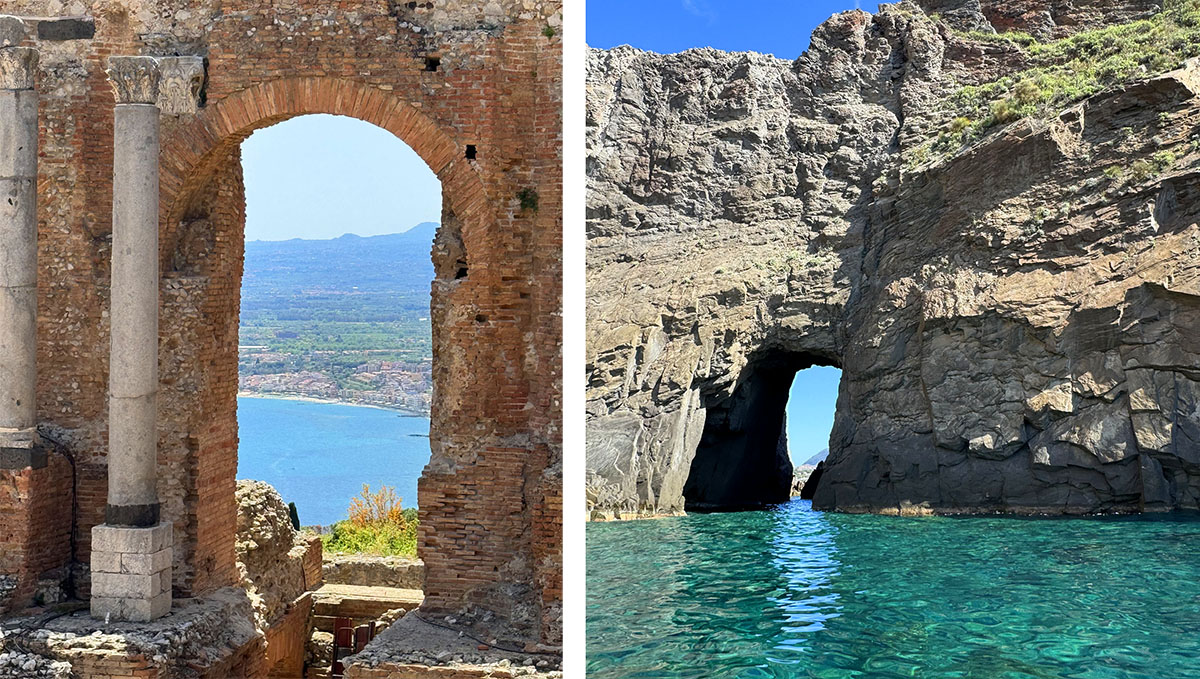
I have always been captivated by Sicily, and so I started my relationship with Walk About Italy on the Secret Side of Sicily. In 1787, the German author Goethe said: “To have seen Italy without having seen Sicily is not to have seen Italy at all, for Sicily is the clue to everything.”
Each day includes a gentle, two-hour hike (a 4-6 km walk), usually in the morning, to burn off the delicious buffet breakfasts (both hotels on this trip offer mouthwatering morning indulgences) and work up an appetite for the delectable lunches and dinners. The walks are diverse, not strenuous—walking sticks are included—and, without exception, stunning.
The Sicilian Odyssey includes the eastern coast of Sicily, the largest island on the Mediterranean, and a visit to three of the seven Aeolian Islands.
Every site, every hike, every off-the-beaten-track location — as well as every bite has been chosen first-hand. “We visit farms where we can talk to farmers, we go to family-run hotels and restaurants and we amend the trips as we discover new exciting places. We only hire locals to create the best trip possible. We find the secret gems.”

ABOVE: The ancient combines with the modern in Ortigia. The Fountain of Arethusa is a natural spring in Ortigia.
While this is a hiking trip, and the map may look like a daunting area of land to explore, fret not. Most of the distance is covered by a small, comfortable bus and, of course, ferries to get to the islands.
Siracusa (Syracuse) Cicero loved it and so will you. This UNESCO World Heritage site bears witness to the development of Mediterranean civilization over three thousand years. Even attempting to grasp the history here is overwhelming. It is the kind of place that lingers in your mind as you walk in the footsteps of Plato and Archimedes in ancient Syracuse (Ortigia.)

ABOVE: Fountain of Diana in old Siracusa. RIGHT: Ancient Ortigia, where Plato and Archimedes tread.
One of the beautiful features of Syracuse is how the ancient is mixed with the modern. The sites are protected but also integrated into daily life. Next to the Temple of Apollo, dating back to the 6th century BC, is a bustling piazza and market. There is “timeless beauty, where history dances with contemporary charm.” (Ok, Oscar Wilde said that about Taormina but it also applies to Syracuse.)
Sleep. Sadly, it is a necessity, but the luxurious five-star Caportigia Boutique Hotel, home base for two days, makes for perfect slumbering. Their buffet breakfasts are fabulous, and the outdoor hot tub is a treat.
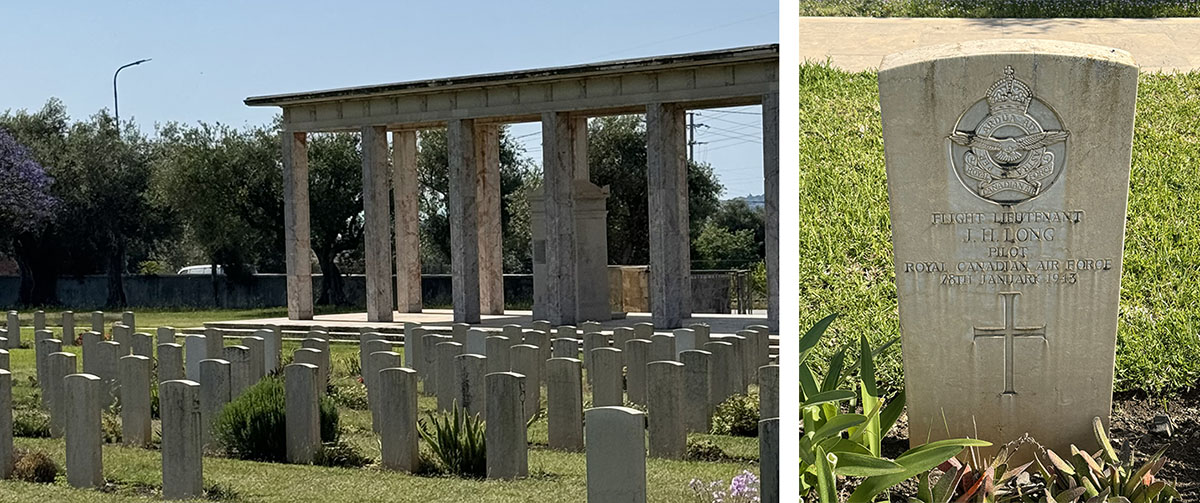
ABOVE: Commonwealth Graves Commission cemetery for the Italian Campaign, where Canadians fought.
One of the surprising spots near Syracuse is a Commonwealth War Graves Commission cemetery with fallen war heroes from the 1943 Italian Campaign. It is an extremely moving site, and there is a number of Canadians buried there. History of every era surrounds you in Italy.
Vendicari Nature Reserve
This is the first major hike (6 km) of the trip. Birders will adore the over 200 species that have been observed here (including flamingos, herons, and storks), and there are observation decks where you can see some of these majestic animals. The Tonnara di Vendicari, a sophisticated 17th-century tuna processing plant on the water, is now a museum and provides a fascinating look at the industry of that period.
This is such a peaceful, scenic hike, and there is something magical about walking along ancient paths that were quite literally the highways of the ancient world.
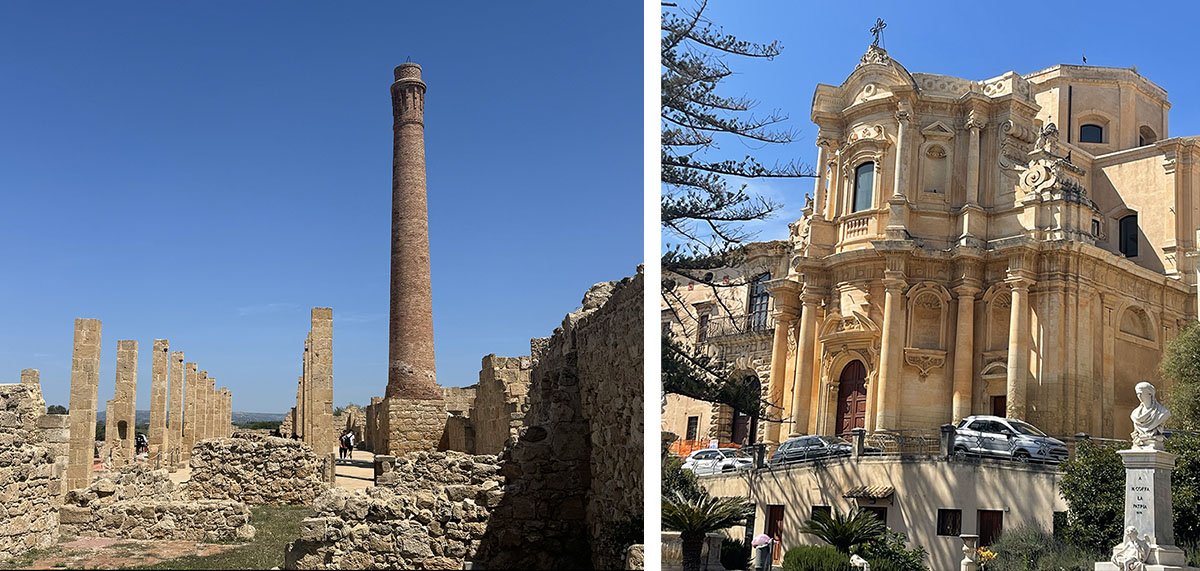
ABOVE: 17th-century tuna processing plant in Vendicari. RIGHT: Baroque Noto.
The nearby village of Noto is a testament to human strength and spirit. It was completely destroyed by a devastating earthquake in 1693. As a symbol of the resilience of the people, it was rebuilt with ornate, exquisite Baroque architecture. As such, it is also a UNESCO World Heritage site. (It is also known for its gelato and granita shops, so indulge.)
Taormina “In the sun-kissed embrace of the Mediterranean, there exists a town that epitomizes the allure and enchantment of the region, Taormina. Nestled on the rugged cliffs of Sicily, this gem of antiquity captivates all who have the privilege to wander its cobblestone streets.” I couldn’t have described it any better. Oscar Wilde penned those words, calling it “a town steeped in history, that unfolds like a canvas painted by the gods themselves.”
No surprise, it has attracted wealth and Hollywood. Episodes of The White Lotus were filmed here. While there is high-end shopping, fun, quirky shops are entertaining to pop into as well, or just sit on a patio on one of the narrow streets or alleys and people watch during your free time in Taormina.
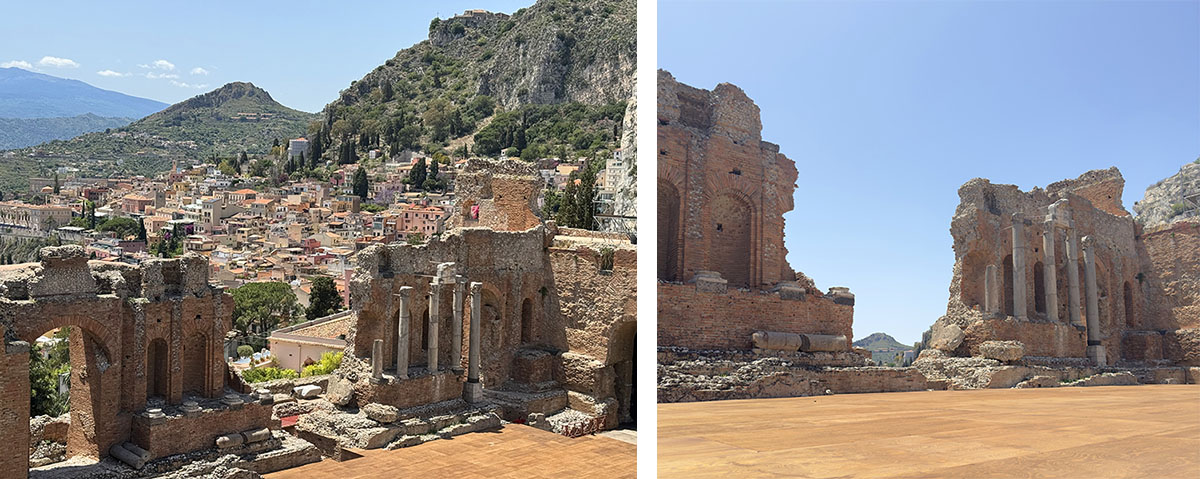
ABOVE: Baroque Noto RIGHT: The grandiose Teatro Antico in Taormina.
But without a doubt, the magnificent Greek Teatro Antico, a breathtaking architectural wonder built in the 3rd century BC, is the star of Taormina. Its history, views of Mount Etna, of the coast and of the vibrant town are unlike anything you will ever see. (The Teatro has also appeared in movies, as one might expect, including Mighty Aphrodite.)
Aeolian Islands
This rugged chain of seven islands was declared a UNESCO World Heritage site in 2002 because of its importance for volcanic studies. The soil is rich for growing the wide variety of flavours that make Sicilian cuisine so delectable, and the islands are a hiking heaven.
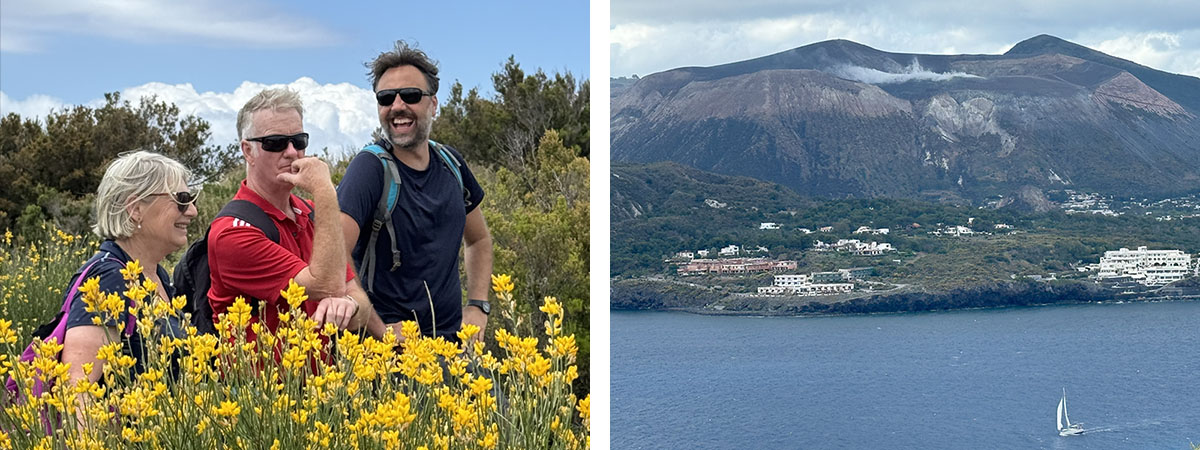
ABOVE: Fellow Walk About Italy travellers from around the world become friends. RIGHT: Hike in Lipari with views of Vulcano.
Lipari. A hydrofoil ride from mainland Sicily lands you in Marina Corta, a bustling and quaint port that leads to narrow, winding streets. Lipari is enchanting and the biggest Aeolian island. It is home base for four days at the four-star AKTEA Resort (take advantage of the warm and large pool or enjoy your own patio.)

ABOVE: A short walk from the Osservatorio Geofisico de Lipari.
One hiking destination is the Osservatorio Geofisico di Lipari, which served as a seismic research centre in its day. It offers a stunning view of the island of Vulcano and the rugged cliffs that mark the area.
The word “volcano” comes from the island of Vulcano, which claims its name from Vulcan, the Roman god of fire. No wonder Italians are full of fiery passion. This hike was a personal highlight, winding our way from the town up to the main crater, the Caldera de La Fossa. It is a large, as in 500 metres in diameter, bubbling cauldron with vents spewing out sulphur steam. The panoramic view from the top is humbling, peaceful and breathtaking all at the same time.

ABOVE: Breathtaking scenery awaits at the caldera. RIGHT: Chef and entertainer during lunch in Salina.
Back down in the village (a much easier hike down,) you can swim in a warm sulphur mud pit or take a dip in the ocean, which also has bubbling vents. (Beware of wearing jewellery in these waters as the sulphur tarnishes metals.)
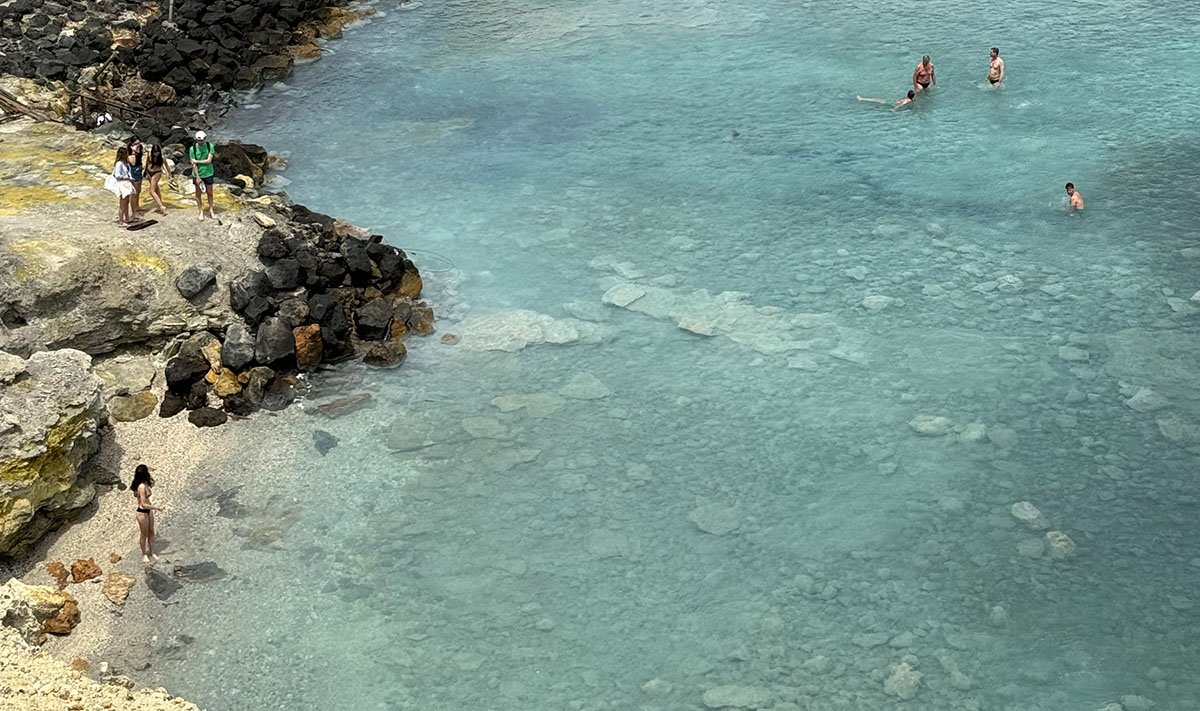
ABOVE: Sulphur vents warm the water in Salina, but beware, it tarnishes metal, including your silver jewellery!
The peaceful day trip to Salina, the second biggest of the Aeolian Islands, is all about stunning hiking in serene surroundings. Lunch on the mountainside, just our group, overlooking the ocean and being serenaded by our guitar-playing host, was divine.
On the way back to Lipari, cool off by jumping off the ferry to swim in the deep blue waters.
The Joy of Eating
Eating in Italy is an experience and in Sicily this is especially the case. The cuisine in this delectable region is a blend of flavours, all influenced by the Mediterranean and the surrounding volcanic soil, rich in nutrients. The wide variety of fruits and vegetables that Sicily has been known for centuries, if not millennia, can be enjoyed today, as they were so long ago. Fresh seafood, aromatic herbs, citrus fruits, olives, olive oil, pistachios, eggplant, tomatoes and capers all combine to create a culinary experience distinct from other Italian regions.

ABOVE: Dining al fresco, the Sicilian way, involves a table laden with plates to share. RIGHT: Kind, affable guide Ermes with the steaming Vulcano Island in the distance. Sicilians love their carbs.
Ermes, your affable guide, chooses every meal carefully to highlight all the fabulous flavours and specialities. He also provides lots of fun facts about Sicily and ensures every detail is perfectly taken care of.
Picture long tables, multiple dishes with various flavours, dining al fresco with local wine. Curated meal locations also include pastoral settings, postcard mountain scenery or small family-run restaurants. Each meal is delectable and different.
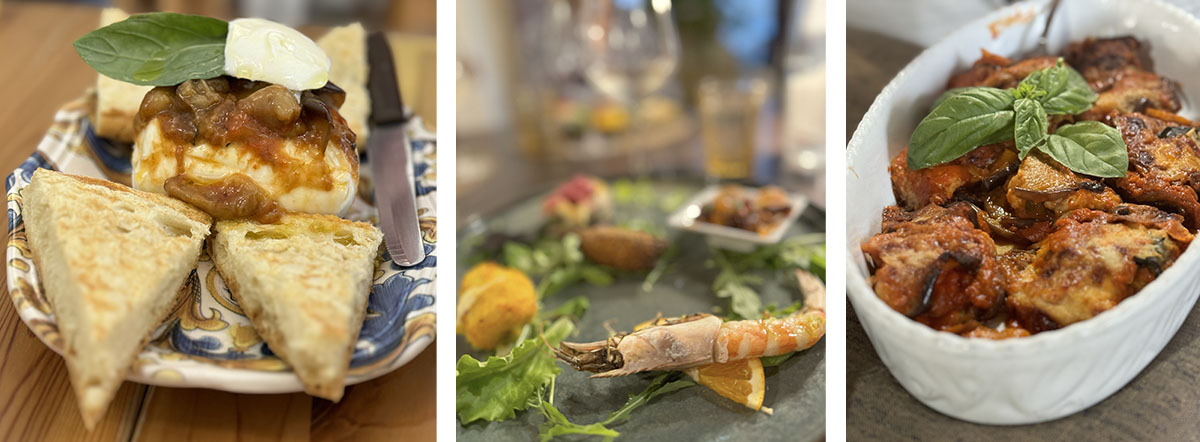
ABOVE: Every area in Sicily has specialities but eggplants and seafood feature prominently.
Sicilians have a sweet tooth so do not miss any opportunity to enjoy gelato and granita (flavoured ice) as you wander. Splurge on pastries, the pistachio-filled croissants at AKTEA are divine. Ermes won’t let you leave Sicily without trying cannelloni, a Sicilian original that makes every carb worth it.
To savour Sicily is to savour life, and there is nobody better to show you this than the Walk About Italy family. I am already excited about my next adventure, the Cinque Terre trip – one that will allow me to savour Italy in a different way.





